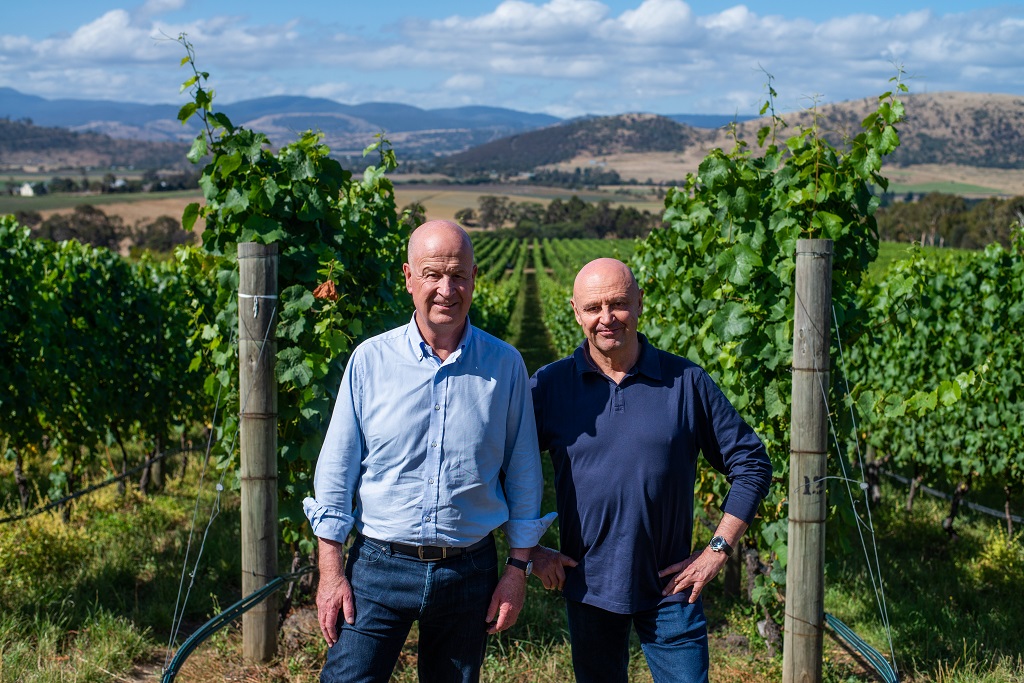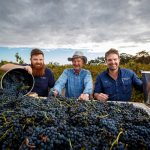Owners Martin Shaw and Michael Hill Smith MW, Tolpuddle Vineyard. Photo: Chris Crerar
By Mark Smith in Tasmania
Few achievements provide better validation of grower viticulture than major awards on the international wine stage.
Consider Tasmania’s Tolpuddle Vineyard and it seems such endorsements appear with astonishing regularity.
Three International Wine Challenge trophies last year focussed attention on the 2020 Chardonnay. (Two years earlier, it was five trophies for the 2018, including Champion White Wine.) By December 2022, international acclaim had passed to the 2021 Chardonnay, named Decanter‘s White Wine of the Year.
“This vineyard has achieved some amazing feats,” admits manager Carlos Souris.
“It’s been an incredible 12-year journey for Martin Shaw and Michael Hill Smith MW; a genuine team effort, combining passion and vision with world-class viticulture and winemaking.
“Hats off for the owners recognising Tolpuddle as a truly distinguished site for producing table wines in the classic style. They knew it had great bones when they bought it in 2011. It just needed whipping into shape.”
Three far-sighted entrepreneurs gave heart and soul to the vineyard in the 1980s. They were local agribusiness operator and StrathAyr Lawn boss Bill Casimaty, Victorian winemaker/viticulture consultant Garry Crittenden, and Dr Tony Jordan, then managing director of Domaine Chandon Australia.
The name evokes memories of the Tolpuddle Martyrs; six English farm workers from Tolpuddle in Dorset, sentenced to penal transportation to Tasmania in 1834. George Loveless, a key figure in the group, spent part of his sentence farming GlenAyr, the Richmond property later owned by the Casimaty family.
Now 32ha, the vineyard overlooks the historic township of Richmond, 20km from Hobart. It was established as a joint venture to supply cool climate sparkling wine grapes to Chandon’s Yarra Valley winery.
Tasmanian Premier Robin Gray added his imprimatur to the project by planting its first nursery cuttings in 1987. From 1988 to 1999, 20 blocks of Chardonnay and Pinot Noir were laid out on the east-facing site, each developed according to industry best practice.
“It wasn’t until select parcels of Tolpuddle fruit played small but vital roles in icon wines like Eileen Hardy Chardonnay and Eileen Hardy Pinot Noir that the site’s true potential became apparent,” Souris notes.
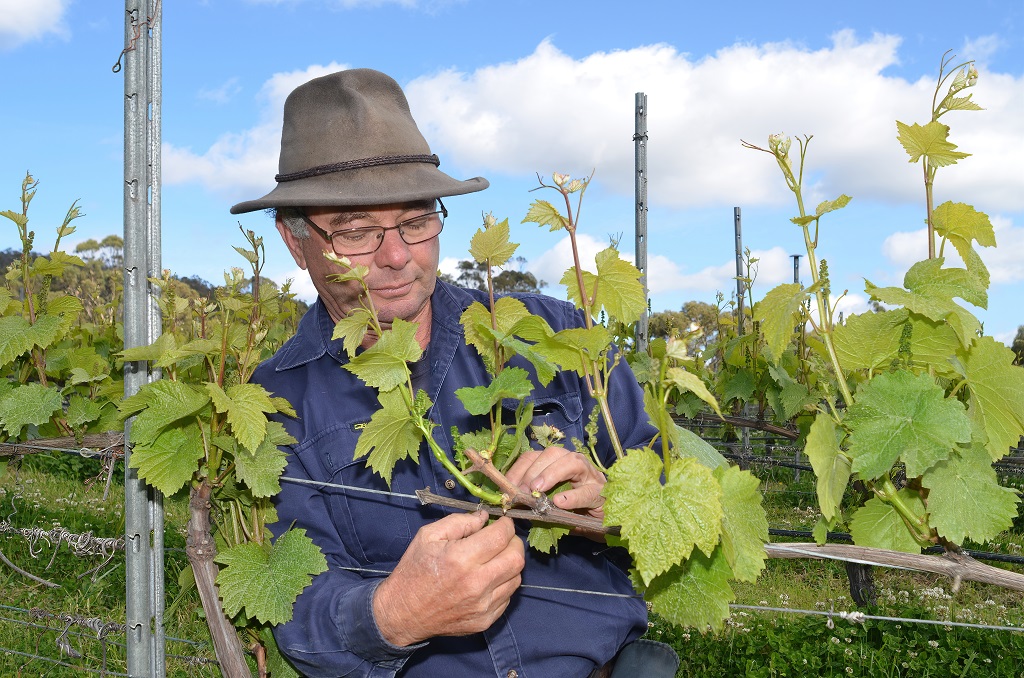
“Martin and Michael had no intention of making sparkling wine from their 20ha of vines. That meant commitment instead to some major undertakings in order to make the site better suited to single vineyard Chardonnay and Pinot Noir.”
Souris took on his leadership role in August 2012. His first move was to recommend purchase of a 20-tonne excavator. Indeed, he told Shaw and Smith exactly where they could buy one to begin work immediately.
“The idea of using such a blunt instrument raised a few eyebrows, especially among the locals,” the industry veteran muses.
Wish granted, Souris spent two years sculpting and re-defining landscape that in 2006 had been named Tasmanian Vineyard of the Year by the State’s Royal Agricultural Society.
Re-development plans commenced well before Souris joined the team. The appointment of Ray Guerin as Shaw + Smith group viticulturist in October 2011 added impetus and fine detail to a work in progress.
Guerin played to his strengths in fulfilling his role. Regarded as one of Australia’s foremost cool climate viticulturists, he spent 25 years with Hardys, Constellation and Accolade. Tolpuddle was familiar territory while he managed grower relations and fruit purchasing.
Now working alongside company viticulturist Murray Leake, Souris has an extensive ‘to do’ list. Tasks to date include removal of 3ha of windbreaks, rogue eucalypts and under-performing blocks and clonal selections. Additions feature new water storage, vermin-proof fencing and certified planting material. Upgrades to drainage and differential irrigation systems support wetted strips and frost mitigation.
Purchase of an adjacent parcel of land and subsequent planting have created entire new blocks, while re-jigging pruning, canopy management and infrastructure like posts and wires has revitalised older blocks.
Adam Wadewitz believes the changes have added nuance to grape and wine quality.
The University of Adelaide oenology graduate has presided over Tolpuddle winemaking since 2013. Named Winemaker of the Year 2022 by Wine Magazine, his chief winemaker position at Shaw + Smith is augmented by the joint CEO role he shares with David LeMire MW at the company’s Balhannah HQ.
Wadewitz hails from McLaren Vale. His commitment to sustainable farming and responsible land management began there with the family’s nursery business.
“Tolpuddle is super exciting,” he says.
“It’s like growing grapes on another planet. As a Chardonnay winemaker, you basically throw out the Adelaide Hills rule book and take a completely different approach.”
“Ripening is much more gradual and the fruit intensity really builds over time. In the Hills, you often find sugars are racing towards harvest. Picking decisions are critical. Natural acidity is always a strong point in Tasmania.
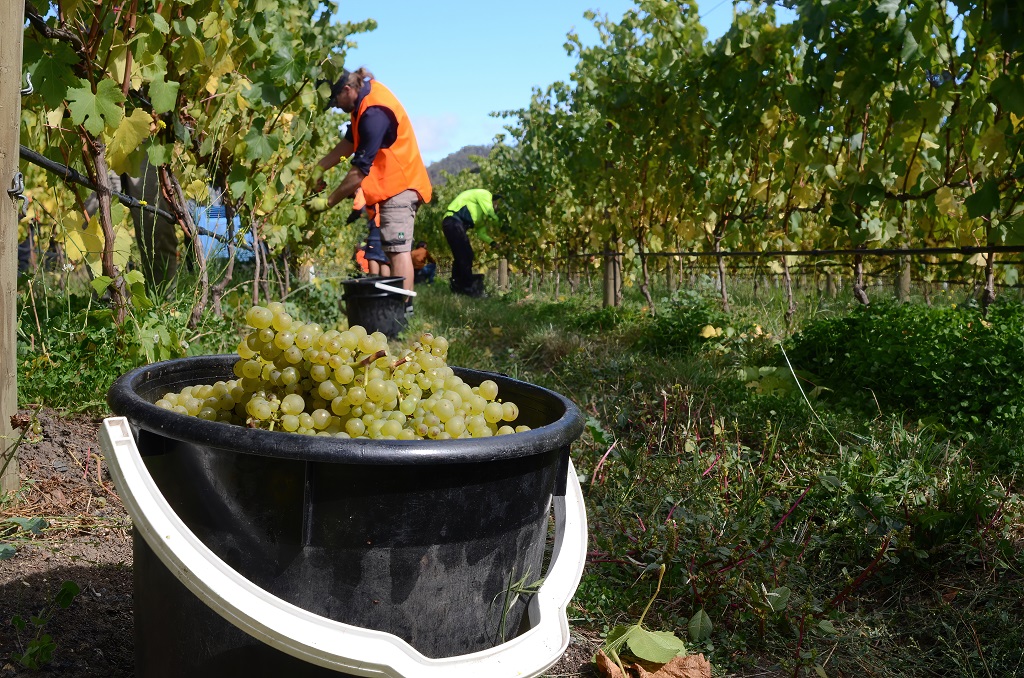
A great place ‘to capture in a bottle’
“It’s a beautiful pristine environment. Cool and relatively dry around Richmond, it’s ideal for Chardonnay and Pinot Noir. When you’re there, you know you’re in a special part of the world. It’s a great place for a winemaker to try to capture in a bottle.”
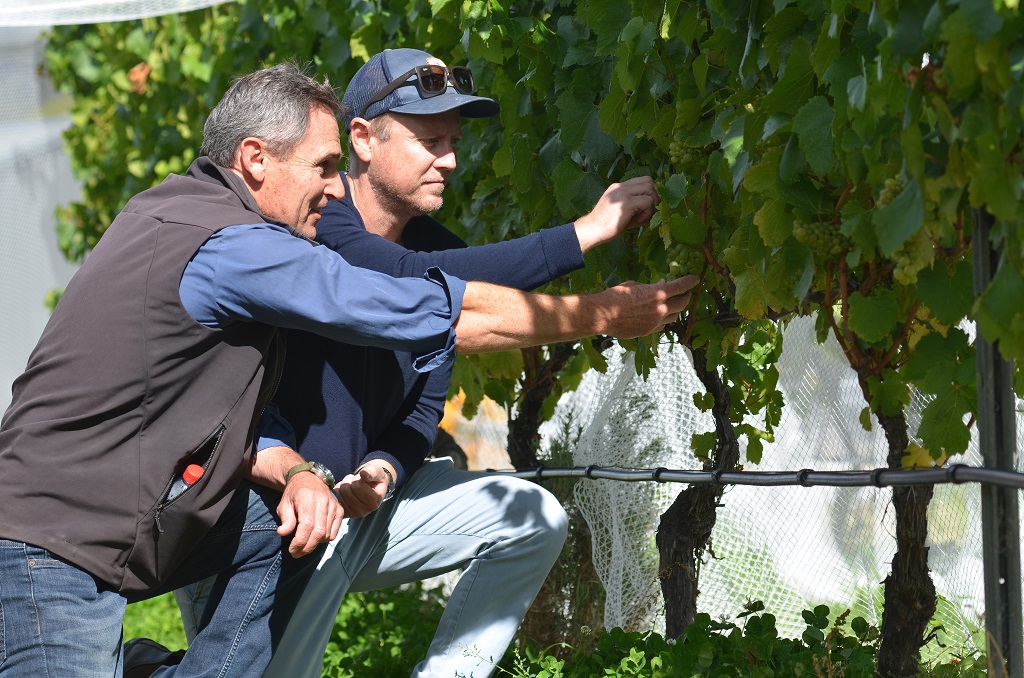
Wadewitz’s observations are supported by Bureau of Meteorology data1 from GlenAyr, just over the road. The records also underscore the intrinsic value of the South East Irrigation Scheme in distributing potable water through the Coal River Valley.
Richmond’s average annual rainfall since 1988 is 511mm, much lower than Balhannah (726mm). Scattered rainfall occurs throughout the year at Tolpuddle. Average June, July and August totals in the Adelaide Hills all exceed 100mm.
Tasmania is exposed to strong winds at the Roaring 40s. In late spring, they provide a challenging counterpoint, often showing more detrimental effects on flowering and fruit set than wet weather alone.
That makes Leake’s annual bud dissection program across all Shaw + Smith sites especially beneficial. It provides not only a blueprint for pruning but something of a safety net in the case of adverse, early season growing conditions.
“Our low rainfall comes with high evaporation rates,” Souris continues.
“Weak, very shallow sandy soils drive low fertility, so our recipe for success is often more about eliminating vine stress than vine vigour. You have to watch plant growth a lot more than you’d expect.”
Soil structure, water-holding capacity and overall health and biomass have improved markedly over the decade; proof that rotary hoeing and on-site creation and application of biochar and organic compost are reaping rewards.
Souris’s 20-tonner makes light work of aerating and spreading the 20m3/ha of compost required each year. Targeted use of the excavator not only helped rejuvenate rootzones, it also remedied poor early shoot growth on the vineyard’s upper slopes.
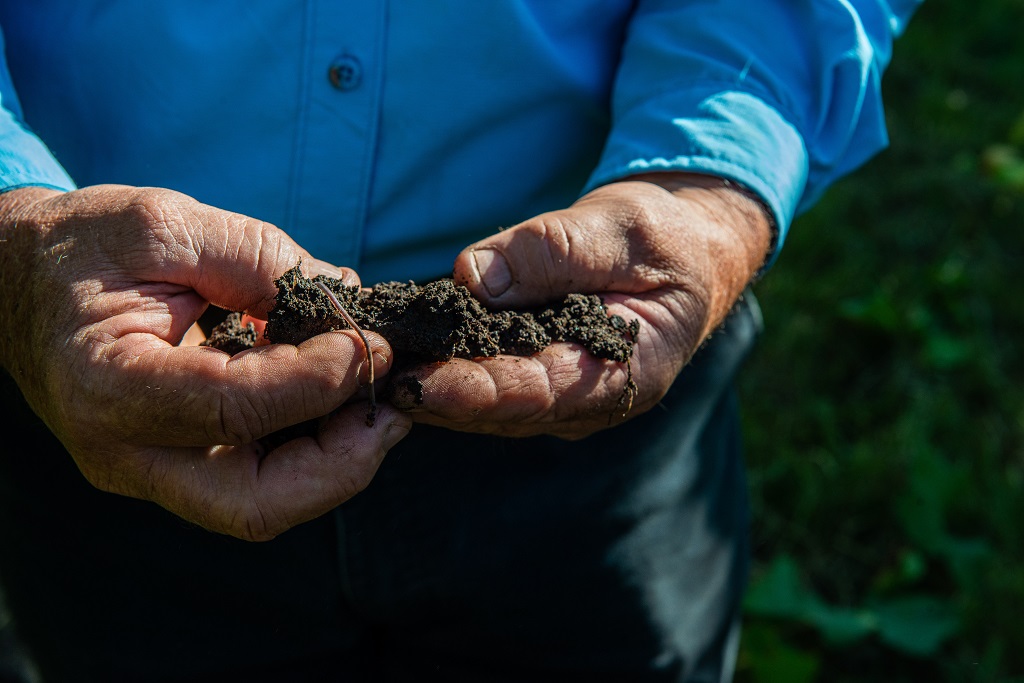
“Excavation allowed us to see that vine roots were dying back in winter due to large volumes of run-off moving down the hill,” Souris says.
Cropping levels today are half the 15t/ha and more achieved when production was dedicated to sparkling wine. Blocks that struggle to meet demanding fruit specifications are being removed and replanted with new material on its own roots.
Winter pruning, subsequent shoot-positioning and leaf finessing are carried out by a highly trained vineyard crew, led by Wendy Borg.
“They look at every shoot and every bunch, making sure each is in an optimum location, free from overcrowding,” Souris notes.
“As harvest nears, senescing leaves are continually removed so they don’t fall on bunches below if it rains, adding disease pressure.”
Chardonnay clones include historic selections I10V1, I10V3 and P58 (‘Penfolds’). Early plantings of G9V7 also remain, while Bernard 76, 95 and 96 have been joined by clone 548; comparatively new to Australia but highly regarded in France since the 1970s.
“The original Chardonnay had fairly narrow row spacings but relatively wide spacings between vines – 2.2m between rows and 1.2m between vines,” Wadewitz says.
“We know when you get the yield per vine down you get a better expression of site, so we’ve gone to 0.75m spacings between vines on new plantings. The density is just under 7000 vines/ha. It works brilliantly. Close planting applies on our new Piccadilly vineyard, too.”
Grafting is seldom reliable and cost-effective under Tasmanian conditions. Vine density on some older blocks has been increased by adapting traditional layering techniques.
New plants are created from existing vines by cutting established trunks 30cm above the ground.
Two healthy new shoots are selected from the resultant spring and summer growth. One provides a new trunk for the mother vine. The other is buried alongside during winter dormancy, well below existing irrigation and foliage wires.
“It means sacrificing a year’s crop, but the payback is a new plant with its own root system; growth supported by a mother vine,” Souris explains.
“Instead of competition, nutrients are shared until each new vine can fend for itself. The process works well but it’s labour-intensive. Shoots being layered need to be buried deeply and properly secured.”
Pruning remains the subject of ongoing discussion and assessment. Spur-pruning, commonplace in the 1990s, has generally given way to cane-pruning. But Souris says there has been a return to spurs in some locations because the team like the fruit quality evident in the small bunches it produces.
If the jury is still out, that shouldn’t surprise anyone familiar with Tasmanian viticulture.
A recent three-year study by the University of Tasmania concluded Chardonnay and Pinot Noir quality could be improved by shifting from the industry norm of cane pruning to spur pruning, at least for sparkling wine. However, seasonal variability ‘was also apparent in this study.’ 2
Tolpuddle, like Tasmania itself, is no one-trick pony.
References
- www.bom.gov.au/climate/data/
- Jones, JE et al. Spur pruning leads to distinctly different phenolic profiles of base sparkling wines than cane pruning, Vitis vol 57, pp. 103-109 (2018).
This article was originally published in the July 2023 issue of the Australian & New Zealand Grapegrower & Winemaker. To find out more about our monthly magazine, or to subscribe, click here!
Are you a Daily Wine News subscriber? If not, click here to join our mailing list. It’s free!

